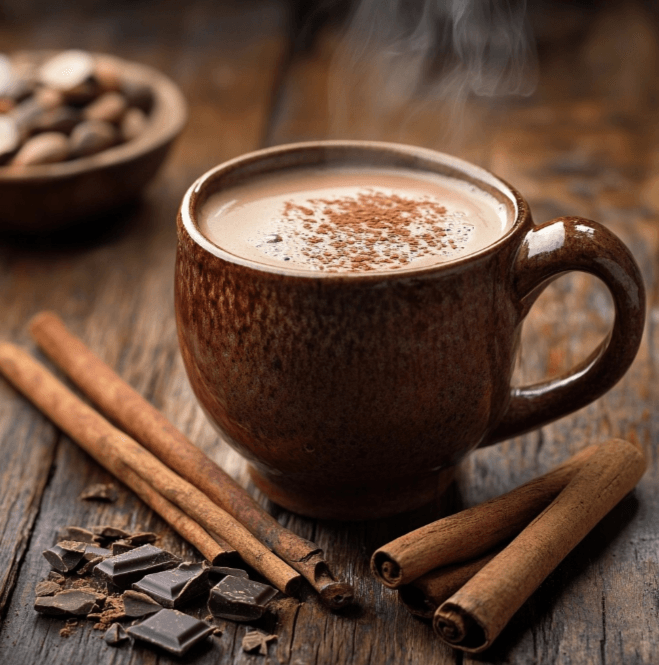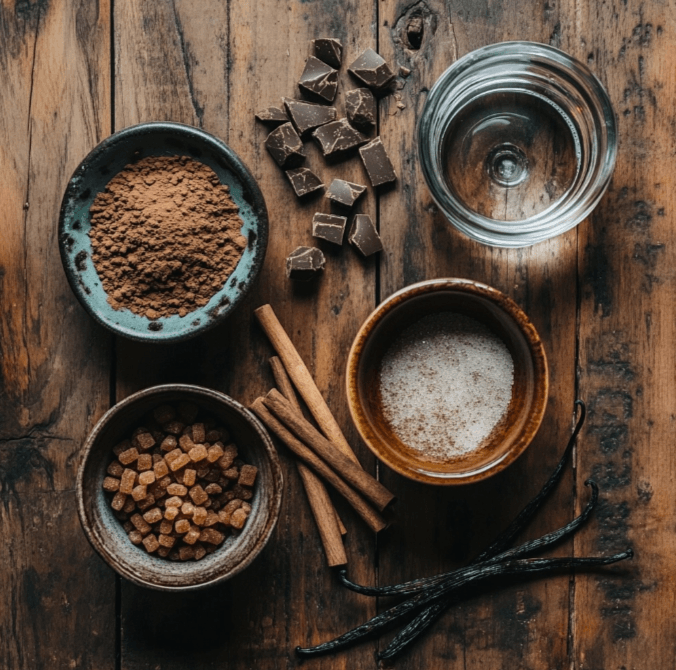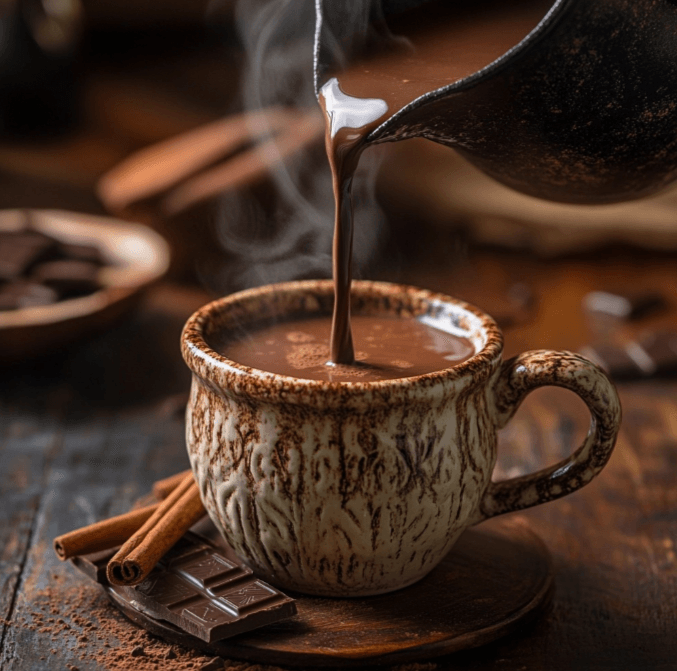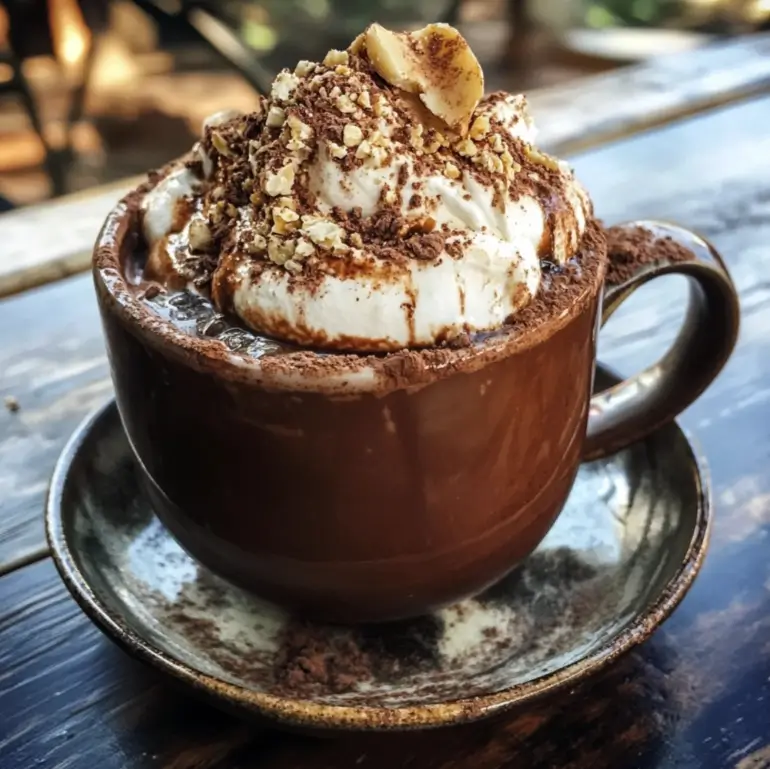Introduction
Few drinks embody the rich tapestry of a nation’s history, flavor, and culture as Mexican hot chocolate does. This beloved beverage offers a unique combination of deep, earthy cacao flavors, aromatic spices like cinnamon and vanilla, and a velvety, frothy texture. Unlike traditional European hot chocolate, which tends to be smooth and creamy, Mexican hot chocolate is intentionally rustic and bold, celebrating its roots in ancient Mesoamerican traditions.
Originating from the Mayan and Aztec civilizations, where cacao was considered a divine gift, Mexican hot chocolate has transformed over centuries. It retains its cultural significance in Mexico, enjoyed both as a daily comfort drink and during special occasions like Día de los Muertos and Christmas festivities. The preparation itself is an art, often involving a molinillo, a wooden whisk used to froth the chocolate into a creamy delight.
In this article, we’ll explore the history, ingredients, preparation methods, and cultural significance of Mexican hot chocolate. Whether you’re a connoisseur or a curious novice, this guide will inspire you to discover the warm, spiced world of this timeless drink.
Table of Contents
History of Mexican Hot Chocolate
Origins in Mesoamerican Cultures
The story of Mexican hot chocolate begins with the ancient civilizations of Mesoamerica, particularly the Mayans and Aztecs. For these cultures, cacao was not merely a food but a sacred gift from the gods. The Mayans prepared cacao as a bitter beverage called xocolatl, mixing it with water, chili peppers, and other spices. This drink was often consumed during religious ceremonies and rituals, symbolizing vitality and connection to the divine.
The Aztecs later adopted cacao, elevating its significance even further. Cacao beans were so valuable they were used as currency. The Aztecs prepared cacao as a frothy drink, enjoyed by nobles, warriors, and priests. Unlike modern sweetened versions, the Aztec preparation emphasized cacao’s natural bitterness and incorporated chili and spices for a robust, invigorating flavor.

European Influence and Transformation
When Spanish explorers arrived in Mexico in the 16th century, they were introduced to cacao. Initially unaccustomed to its bitter taste, the Europeans added sugar and cinnamon, which were not part of the indigenous recipes. They also began incorporating milk, transforming the drink into a sweeter and creamier version more palatable to European tastes.
This fusion of Mesoamerican and European traditions laid the foundation for what we now recognize as Mexican hot chocolate. Despite these adaptations, the drink has retained its rustic charm and essential ingredients, particularly the use of cacao, spices, and a frothy texture.
Modern-Day Evolution
Today, Mexican hot chocolate is a cherished part of Mexico’s culinary heritage. Brands like Abuelita and Ibarra have popularized pre-made chocolate tablets infused with sugar and cinnamon, making it easy to prepare the drink at home. Despite modern conveniences, many families still prepare hot chocolate using traditional methods, honoring the rich history of the drink.
Ingredients of Mexican Hot Chocolate
Core Ingredients
- Cacao
Cacao is the foundation of Mexican hot chocolate, valued for its robust, earthy flavor. Unlike processed cocoa powders, traditional cacao retains its natural bitterness and texture, contributing to the drink’s authentic taste. - Cinnamon
Cinnamon (canela), a staple in Mexican cuisine, adds warmth and a sweet-spicy aroma. It complements the intensity of the cacao and is a key component of the drink’s signature flavor profile. - Vanilla
Vanilla, native to Mexico, enhances the richness of the hot chocolate with its subtle floral notes. It is often used in traditional recipes for a more rounded flavor. - Sweetener
Sugar, usually in the form of piloncillo (unrefined cane sugar), balances the cacao’s bitterness with a natural, caramel-like sweetness. - Liquid Base
Mexican hot chocolate is traditionally made with either water or milk. Water brings out the bold flavors of cacao, while milk adds a creamy texture. Some recipes use a combination of both for balance.

Variations and Modern Touches
Modern adaptations of Mexican hot chocolate often include creative twists while maintaining the essence of tradition:
- Spicy Versions: Adding chili powder or cayenne for a hint of heat, reminiscent of the Aztecs’ original recipes.
- Nuts and Spices: Incorporating ground almonds or nutmeg for a richer flavor.
- Vegan Options: Plant-based milks like almond, coconut, or oat milk are popular dairy-free alternatives that maintain the creaminess. For more on the benefits of almond milk, visit The Benefits and Uses of Almond Milk for a Healthy Lifestyle.
- Convenient Chocolate Tablets: Brands like Abuelita and Ibarra simplify preparation while preserving traditional flavors.
Preparation Methods
Traditional Tools and Techniques
- The Molinillo
One of the most iconic tools in preparing Mexican hot chocolate is the molinillo, a hand-carved wooden whisk. This tool is used to froth the hot chocolate, creating a light and creamy texture. To use it, the molinillo is placed in the pot of chocolate, and its handle is spun between the palms to whip air into the mixture. - The Traditional Pot
Hot chocolate is often prepared in a clay pot, known as a cazuela. The porous material of the pot enhances the flavors of the ingredients, adding an earthy undertone to the drink.
Step-by-Step Recipe
Ingredients
- 4 cups of milk (or water for a traditional flavor)
- 1 tablet of Mexican chocolate (such as Abuelita or Ibarra)
- 1 cinnamon stick (optional for extra flavor)
- A pinch of chili powder or cayenne (optional for spice)
Instructions
- Heat the Milk or Water: In a medium saucepan, heat milk or water over medium heat until it begins to steam.
- Add the Chocolate: Break the chocolate tablet into smaller pieces and add it to the liquid.
- Stir or Whisk: Use a molinillo or whisk to mix the chocolate until it dissolves completely.
- Froth the Mixture: If using a molinillo, roll it between your palms to create a frothy texture.
- Serve and Enjoy: Pour the hot chocolate into cups and serve immediately. For a festive touch, top with whipped cream or a sprinkle of cinnamon.

For more creative hot chocolate recipes, explore Hot Chocolate Bombs: A Complete Guide.
Cultural and Social Significance
A Symbol of Community
In Mexico, hot chocolate is often associated with togetherness and hospitality. It’s a drink that brings people together, whether shared during festive occasions or as a comforting treat at home. Its preparation is often communal, with family members working together to create the perfect cup.
Role in Celebrations and Festivals
- Día de los Muertos (Day of the Dead)
During Día de los Muertos, families honor their loved ones who have passed away by preparing offerings, or ofrendas. Mexican hot chocolate is often included as a symbol of warmth and remembrance, served alongside pan de muerto, a sweet, spiced bread. - Las Posadas and Christmas Traditions
Hot chocolate is a staple during Las Posadas, a series of celebrations leading up to Christmas. It is served after reenactments of Mary and Joseph’s search for shelter, paired with tamales and other holiday treats.
Conclusion
Mexican hot chocolate is more than just a comforting beverage—it is a rich tradition that reflects the history, culture, and flavors of Mexico. From its origins in the sacred rituals of the Mayans and Aztecs to its modern-day presence in kitchens around the world, this drink has evolved while preserving its unique identity.
If you’ve never tried making Mexican hot chocolate, now is the perfect time. Armed with traditional recipes, modern variations, and tips for perfect preparation, you can create a delicious cup that honors this beloved cultural treasure.
For additional recipes and culinary tips dive into YummyStates’ Food Guides.

